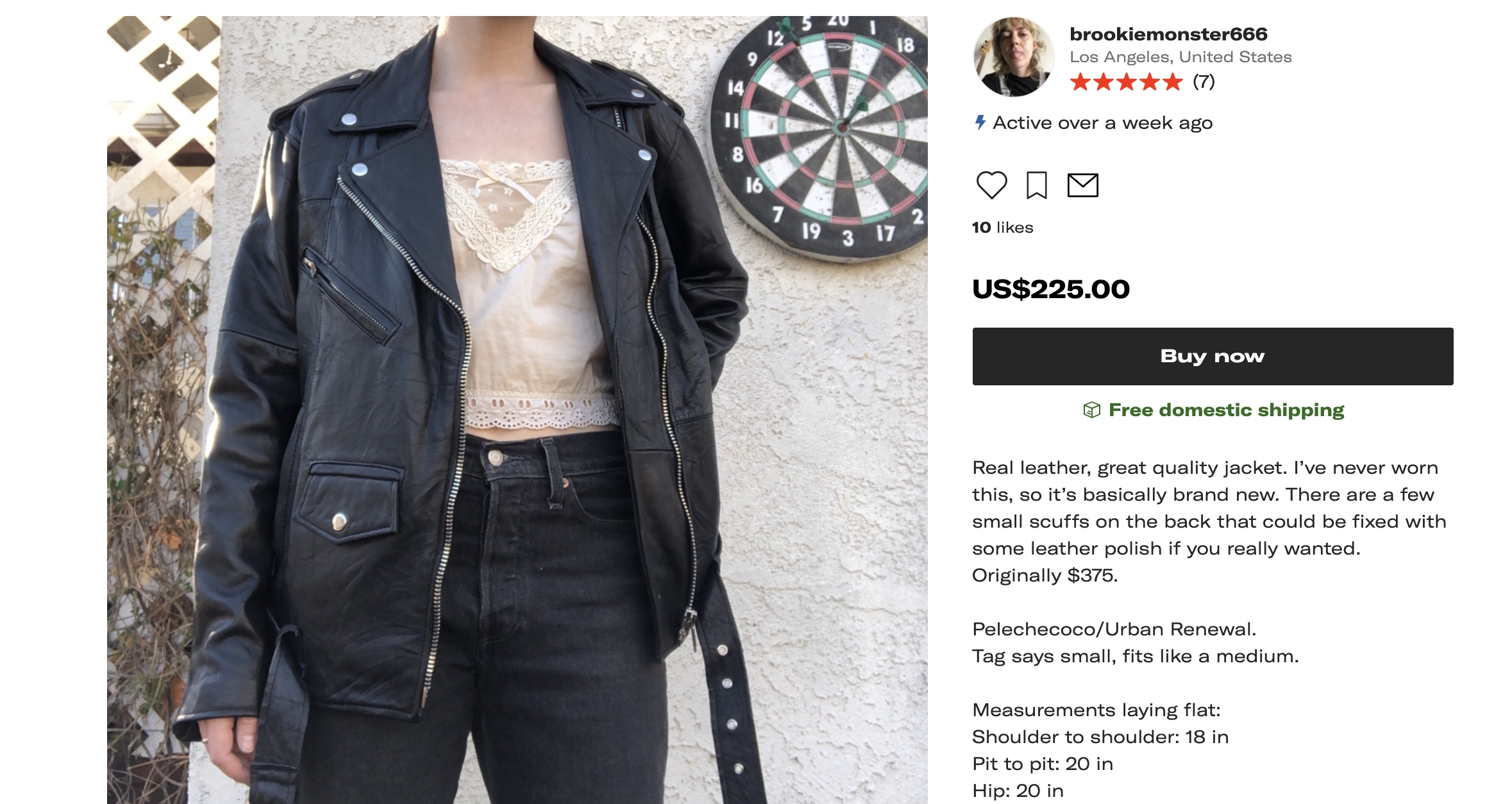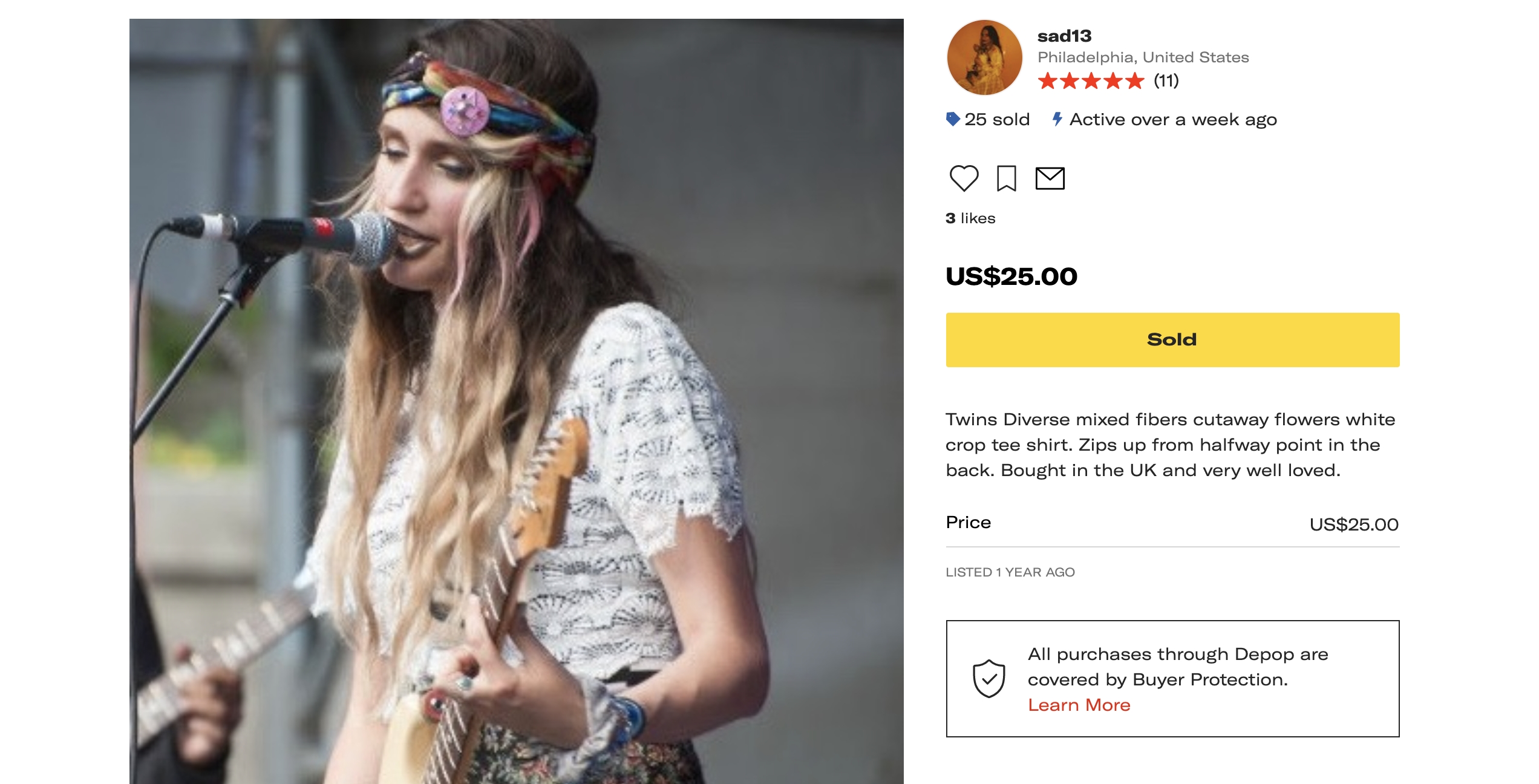
Music and fashion have gone hand in hand for decades. Since the ‘50s and ‘60s, dating back to the rise of Elvis and the Beatles, popular trends in music have influenced how people dress, from mods and the hippies to ‘70s punk styles and glam, and beyond. Today, fashion-conscious shoppers have more outlets than ever from which to choose, but one shopping method has exploded in popularity over the last decade: thrifting. And your favorite musicians are joining in by selling items from their closets.
Thrifting is nothing new, of course. Buying secondhand has long been a way for shoppers to save money, express individuality, and, more recently, reduce their carbon footprint. As buying and selling via secondhand/vintage/consignment apps (Depop, Poshmark, Tradesy, Mercaci, ThredUp) has risen in popularity, musicians have, in addition to the traditional band merch, started selling clothes they’ve worn on tour or for photoshoots, or just happened to have taking up space in their homes.
“What made me start a Depop shop was being a touring musician,” says Brooke Dickson of The Regrettes. “In-between tours, I need to have some kind of income. It’s kind of tough to have a job that you can hold down that’s totally fine with you being on your own schedule.
“I also have so many different costume-y kind of clothes I’ve used for performances and photoshoots,” Dickson adds. “[Selling] accomplishes multiple things at once, where I’m getting rid of old stuff that I don’t need to keep anymore, and then instead of just donating it, I figure I might as well sell some of the good stuff that people like me who would be on Depop as well would be looking for.”

Meanwhile, singer-songwriter Wafia Al-Rikabi, who also sells on Depop, grew up moving from country to country with her family. “We’d always have to pack up and leave, so I would [only] have things that I could fit into one suitcase,” she describes. “I’ve always been a not-owning-a-lot-of-things person because of my parents’ lifestyle.” Now, as a performer, Wafia has a surplus of pieces sent over from brands, and in the last few years, her visibility has increased following her successful cover of Mario’s “Let Me Love You.” Depop, which mainly attracts younger sellers hunting for Y2K-era garments, reached out to Wafia personally. “They reached out to me, and I just have so many things that I’ve only worn once. Even in the process of putting them on Depop, I was trying to be really considerate to not mark up the prices. If you want it, you can have it.”
For Speedy Ortiz singer/guitarist Sadie Dupuis, who also performs as Sad13 and runs a small Depop shop, donating and consigning clothes has been something she’s done since childhood. “I grew up with my mom going to consignment and thrift stores,” she says. “I got Depop when I was first moving to Philly in early 2016, and I had a feeling I was going to have a lot less closet space. I thought, ‘Maybe there’s somebody who wants to wear the dress that I wore to play with Junglepussy or something.’ I would try to put a nice note and some stickers or something, almost to make it like a merch item.”
While some artists look at selling their clothes as a passive side hustle, a pragmatic way to free up space in their homes, others, like Nashville-based performer Stef Colvin, are much more heavily engaged in the process, even making consistent income through thrifting. Colvin’s shop currently has 37K followers; it’s where she sells a wide array of ‘90s and ‘00s pieces to her Gen Z audience, who, Colvin theorizes, are most interested in following multidisciplinary creators who make content that is both aspirational and relatable. “I think [music and fashion] live very cohesively together,” Colvin says. “[Gen Z] is very into aesthetics, they’re into having things that no one else has, some of them are concerned about the environment. That’s why they thrift. Fashion is such a big part of my music branding as well, and I think Gen Z kind of looks for that in artists.”
Artists’ individual reasons for selling can vary, but one thing everyone seems to have in common is the destination: Depop. As opposed to consignment apps like Poshmark, which is probably Depop’s number one competitor, Depop, which was founded in 2011 and is based in London, is more focused on selling one-of-a-kind vintage pieces and tends to draw a younger, more creative class of shoppers.
When Dickson started her shop, she figured more fans of her band would already be Depop customers. “It seems like more young people, more trendy, alternative, whatever you want to call it, people closer to my age and fans of the band, would be on Depop versus Poshmark,” she says. “When I look on Poshmark, I tend to see more, I don’t know, Madewell, J.Crew, stuff like that. I still wear that stuff too, but that just leads me to believe that it’s slightly older, slightly more designer stuff. My older sister, for example, shops on Poshmark more.”
On top of generational consuming habits, the ongoing COVID-19 pandemic likewise plays a role in how artists are selling clothing and other merchandise to their fans. As a Spotify For Artists story points out, last year’s pause in touring meant that artists had to find other methods of engaging with their fans, and fans were hungry for ways to support their favorite artists. As a result, there’s been a marked rise in artist merch sales. Though secondhand selling is not quite the same thing as traditional band merch, artists offering items from their own closets is just another way for fans to foster a parasocial connection.
“I have bought more merch from artists I like during this last year or two than I probably did before,” Dickson says. “We all want to feel connected to the creatives or people we follow online. I think we all want to feel like we know them.”

Taking it a step further, Colvin is convinced that many artists might want to lean harder into the merchandise space. “I honestly don’t think enough artists capitalize off of the merch-clothing element,” she argues. “If you already have a fan base that wants to buy from you, why aren’t you dropping more consistent and better merch? I don’t think enough people do the clothing right, and they’re missing out on a lot of money that they could be making.”
For all of her success selling on Depop, however, Dupuis feels trepidation around the environmental implications when artists feel external pressure to capitalize on their merch. “It really freaks me out that the way that bands have to make money now is by entering the garment industry, which is so messed up for the planet and bands are expected to have, you know, six different, like, cotton t-shirt designs per year,” she admits. “I have complicated feelings about that as a sustainable way for music artists to make their income. There’s so many unseen things that go into making these products when we are in an unprecedented climate crisis.”
That isn’t to say that Dupuis isn’t all for secondhand sales, which is much more environmentally conscious. Likewise, Speedy Ortiz has switched to printing on sustainable materials and selling in lower quantities. But, she points out, artists shouldn’t have to feel like they have to depend on merchandise sales and “run secondhand boutiques” just to survive. “I feel like things produced in limited quantities with secondhand or found materials is a way forward to making an income for artists,” she continues. “But I also just wish that digital music could be valued at a more fair price point so that we wouldn’t have to be brainstorming every which way.”
Some artists covered here are Warner Music artists. Uproxx is an independent subsidiary of Warner Music Group.
